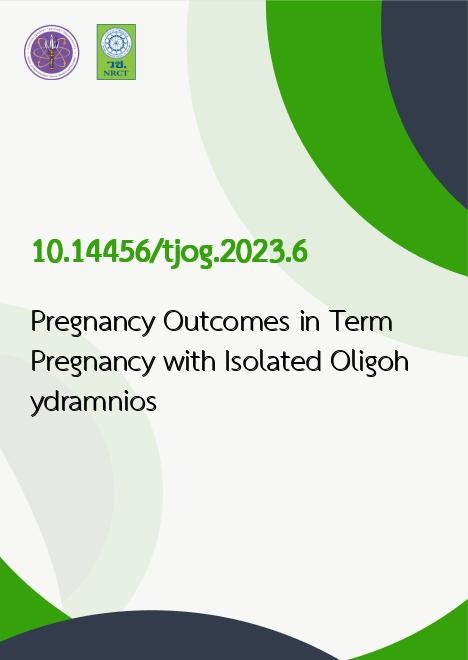
|
Pregnancy Outcomes in Term Pregnancy with Isolated Oligohydramnios |
|---|---|
| รหัสดีโอไอ | |
| Creator | Thamon Niamrat |
| Title | Pregnancy Outcomes in Term Pregnancy with Isolated Oligohydramnios |
| Contributor | Sawittri Suwikrom, Jiraporn Luengmettakul |
| Publisher | PIMDEE Co., Ltd. |
| Publication Year | 2566 |
| Journal Title | Thai Journal of Obstetrics and Gynaecology |
| Journal Vol. | 31 |
| Journal No. | 1 |
| Page no. | 48-55 |
| Keyword | term pregnancy, isolated oligohydramnios, birth asphyxia, cesarean section |
| URL Website | https://tci-thaijo.org/index.php/tjog/index |
| Website title | www.tci-thaijo.org |
| ISSN | 2673-0871 |
| Abstract | Objectives: To compare birth asphyxia between term pregnant women with isolated oligohydramnios and normal amniotic fluid (AFI). Materials and Methods: A retrospective cohort study was conducted in pregnant women who delivered in Charoenkrung Pracharak Hospital from January 1st, 2018, to December 31st, 2020. Obstetrics data and neonatal outcomes were noted among 756 women. Pregnancy outcomes in term pregnancy with isolated oligohydramnios of all 252 pregnant women (study group) were compared to those 504 pregnant women and low-risk pregnancy with normal amniotic fluid index (control group) in 1:2 ratio. Results: The mean of gestational age of all participants was 38.63 ? 1.03 weeks. The mean AFI were 3.72 ? 1.21 cm and 10.73 ? 2.96 cm in the study and control groups, respectively. Isolated oligohydramnios (study group) was associated with a higher rate in nulliparous (46.4% vs 37.4%, p = 0.014) than in the control group. Moreover, pregnant women with isolated oligohydramnios had a significantly higher incidence of birth asphyxia (4% vs 1.4%, p = 0.024), neonatal intensive care unit admission (5.6% vs 0.4%, p < 0.001), and sick newborn admission (21% vs 13.1%, p = 0.005). There was a higher incidence of primary cesarean section in the study group when compared to the control group (30.6% vs 12.3%, p < 0.001). The justification of the higher rate of cesarean section in the study group was non-reassuring fetal heart rate status (14.7% vs 2.6%, p = 0.001) and failed medical induction (8% vs 1.2%, p = 0.001) when compared to the control group. Conclusion: Isolated oligohydramnios in term pregnancy significantly increased the risk of birth asphyxia at 1 min and incidence of cesarean section. |